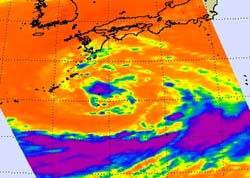Tropical Storm Roke Closing in on Kadena Air Base: Infrared NASA Satellite Imagery

This infrared image of Tropical Storm Roke was captured on Sept. 14 at 10:41 p.m. EDT. The purple area around the center of circulation indicates the coldest, highest cloud heights, where the heaviest rain was occurring. The orange indicates warm sea surface temperatures over 80F that are allowing Roke to intensify. Credit: NASA/JPL, Ed Olsen <br>
NASA's Aqua satellite flew over Roke yesterday and the Atmospheric Infrared Sounder (AIRS) instrument showed powerful convection building around the storm's center and over the northern edge. Meanwhile, dry air is wrapping into the low-level center from the southwest, and limiting cloud development.
Infrared imagery provides forecasters with an inside look into the cloud temperatures and heights, and the colder and higher the clouds go, the stronger they become. Meteorologists at the Joint Typhoon Warning Center use infrared imagery to help create their forecasts. AIRS data also showed sea surface temperatures around Roke to be near 27 degrees Celsius (81 Fahrenheit).
On Sept. 15 at 11 a.m. EDT, Tropical Storm Roke was located approximately 175 nautical miles east of Kadena Air Base, Japan, and is moving west at 6 knots (7 mph). Roke is a minimal tropical storm with maximum sustained winds near 35 mph, but expected to strengthen as it closes in on Kadena Air Base. Warm water temperatures (over 80F/26.6C) and low wind shear are allowing Roke to intensify. Tropical storm conditions are expected at the base from Friday, Sept. 16 through Sunday, Sept. 18 as Roke continues on its westward track.
Text credit: Rob Gutro,
NASA's Goddard Space Flight Center, Greenbelt, Md.
Media Contact
More Information:
http://www.nasa.govAll latest news from the category: Earth Sciences
Earth Sciences (also referred to as Geosciences), which deals with basic issues surrounding our planet, plays a vital role in the area of energy and raw materials supply.
Earth Sciences comprises subjects such as geology, geography, geological informatics, paleontology, mineralogy, petrography, crystallography, geophysics, geodesy, glaciology, cartography, photogrammetry, meteorology and seismology, early-warning systems, earthquake research and polar research.
Newest articles

Superradiant atoms could push the boundaries of how precisely time can be measured
Superradiant atoms can help us measure time more precisely than ever. In a new study, researchers from the University of Copenhagen present a new method for measuring the time interval,…

Ion thermoelectric conversion devices for near room temperature
The electrode sheet of the thermoelectric device consists of ionic hydrogel, which is sandwiched between the electrodes to form, and the Prussian blue on the electrode undergoes a redox reaction…

Zap Energy achieves 37-million-degree temperatures in a compact device
New publication reports record electron temperatures for a small-scale, sheared-flow-stabilized Z-pinch fusion device. In the nine decades since humans first produced fusion reactions, only a few fusion technologies have demonstrated…





















